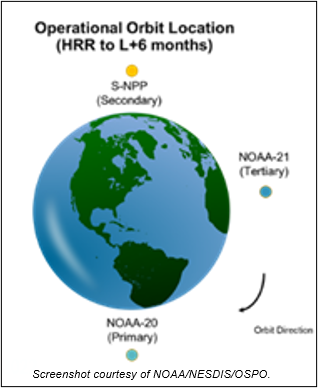When can users expect JPSS Data over CONUS?
The Joint Polar Satellite System (JPSS) constellation consists of 5 satellites: SNPP, NOAA-20, NOAA-21, and the upcoming JPSS-3 and JPSS-4 satellites that will launch within the next decade. Focusing on the three active satellites, the current JPSS orbital configuration has NOAA-20 and SNPP at a 1/2 orbit apart (or ~50-minutes apart) where NOAA-21 is placed 1/4 orbit between the two.
Now this orbital configuration (see the image below) will change once NOAA-21 is designated as the primary satellite later this year. Users can look forward to a future blog entry on that topic.

With the current orbital configuration, how does it translate to when users can expect JPSS data over CONUS? Typically over the lower-48, at any one location, users can expect 3 to 5 overpasses during the overnight hours from approximately 05 to 12Z. During the daytime, 3 to 5 overpasses are expected between ~16-22Z over CONUS.
A nighttime and daytime animation are shown below that highlight JPSS Visible Infrared Imaging Radiometer Suite (VIIRS) swaths over CONUS on 30 July 2023.
Nighttime: 05-12Z, 30 July 2023 – VIIRS swaths from the 11.45 um (I-5 band).
Daytime: 16-22Z, 30 July 2023 – VIIRS GeoColor imagery.
Users should also be aware of the orbital sequence of the satellites. The sequence starts with a NOAA-20 satellite overpass, then a NOAA-21 overpass ~25-minutes later, and then a SNPP overpass ~25 minutes after that. Then there is a 50-minute gap, which then the sequence starts again with another satellite overpass from NOAA-20. Note, this sequence continues as the polar-orbiting satellites move from east to west across CONUS. A VIIRS GeoColor daytime animation (see below) highlights the satellite sequence across CONUS on 19 July 2023.
Additionally, users can identify JPSS orbit tracks (i.e., from near-real-time or archived data) via the Space Science and Engineering Center (SSEC) at the University of Wisconsin polar orbit tracks website. Users can access orbit tracks from SNPP, NOAA-20, and NOAA-21 and can be viewed in a global domain or via regional sector. The length of the archives depends on the satellite. For example, SNPP will have the longest archive, since it is the oldest satellite within the JPSS constellation and contains an archive since 2011. JPSS orbit tracks can be accessed via the NASA SPoRT Viewer webpage as well.
